#verbs in japanese
Photo

Verb aspects in Japanese - ~ている vs. ~る
先生は「あいうえお」と言った
先生は「あいうえお」と言っていた。
What’s the difference between the two? In this case, it is more about your reaction to what you have heard. Are you going to be more like “WTF, man?” or no reaction at all because what you have just heard is a regular/good old quotation (just like you quote someone in your university paper or sth).
ている focuses on your reaction. If I said this exact sentence to you, you’d be surprised and probably asked for some explanation, for example, He said that? Why? WTF?
る focuses on the words in the brackets. This is what he said. He used these exact words, I haven’t changed anything. But you wouldn't be surprised because you just wanted to know the words the teacher used.
~ている is an ending of imperfective verbs - verbs that have no end point. However, that ending implies a myriad of other meanings. In Polish (my native language), we also distinguish between perfective and imperfective verbs only, just like in Japanese. We use, in Polish, imperfective verbs when we talk about
occurring states, the course of which the speaker considers important. (Hence your surprise at the teacher’s words.)
I believe the same rule applies to Japanese ている verbs as well.
る verbs are perfective verbs and these denote something completely opposite - we don’t really care, the course of action is somewhat unimportant for the speaker.
Correct me if I’m wrong!
12 notes
·
View notes
Text
I learned it's easier to learn verbs in their ない form first, vs. their dictionary form first. Makes recognizing the difference between Godan and Ichidan verbs 100% easier and removes the need to "remember" the "hidden/fake/lying" verbs that parade as the other verb type. The trick to doing it is far easier and I hate how Genki teaches it in the book.
Leaving me with only having to learn the conjugation patterns for Ichidan, Godan, and Irregular verbs. Far, far easier.
#learning japanese#fountain pen#jlpt#jlpt n5#kanji#japanese#日本語#senchastudying#studying#studyblr#langblr#language#fountain pen ink#見#Verbs#Japanese Verbs#Japanese Vocabulary#japanese langblr
265 notes
·
View notes
Text
Keroro Movie 4 deleted scene: Shion's Secret, Tamama's Disappearance
This is the scene I've mentioned that had finished animation, there's one version of the movie tie-in credits posted to youtube and you can see one clip there, but they didn't use the exact same mix of clips each week, so there are a couple more shots from the missing scene that were shown.
Removing it must have been a fairly last minute decision, and unfortunately it wasn't included in the bonus features for the DVD, not even the special release. My guess is it was either cut for time, or that it was decided it gave away too much of the story too early, but I wish we could have seen the whole scene in some way, it feels like it would have been really spectacular to see.
This part takes place right after the guest house scene, in the final movie after Tamama runs out of the room it cuts to Momoka waking up, and this scene would have happened between those two points.
Once again, the translation from the novel is under the cut:
---------------------------------------------------------------------------
In the quiet night on the outskirts of Paris, a faint singing voice could be heard. It was such a quiet sound that if you weren't warned of it, you might not notice it, even so, if you listened closely, you could just understand the song.
The singing voice quietly, quietly echoed through the garden where afternoon tea time had been spent, the outer wall of Shion's castle......as well as the guest room on the interior of that, where Momoka & Tamama were sleeping. Nonetheless the two were firmly in the world of dreams. You'd expect they wouldn't notice the singing voice at all.
However.
The sleeping Tamama's eyes suddenly snapped open. The colour of his eyes was different from usual. They were lit up like jewels showered in moonlight. Suddenly waking up, Tamama agilely jumped out of bed. He moved carefully like a child trying to avoid being thought of as bad for waking up in the middle of the night. And so, like that he exited and left the room with soft footfalls.
And closed the door with a click.
Still in her bed, Momoka muttered "Ngh" in response before immediately returning to the world of dreams again. As for the other, now empty bed...... Just where could Tamama be going to?
Tamama ran with tapping steps through the lush, densely growing forest on the other side of Shion's castle. With a blank expression as if he were sleeping with his eyes open, he all around looked like he was being controlled by somebody......
Tamama easily pressed through the pitch-black night forest without stumbling. As he progressed, the singing voice gradually became louder. In a short time, the forest ended and a pond illuminated by the moonlight appeared. The footsteps of Tamama, who had been running through the forest, became slower.
In the center of the pond there was a small island. A small figure seemed to be absentmindedly floating there. The person was likely the one singing the song. Judging by the voice, the one singing was a young girl. But why might a girl be singing in the forest this late at night?
Tamama, who had stopped running at the edge of the pond suddenly came to himself. His eyes returned to their normal colour.
"Huh? Wha-what-what? Where is this place?" Despite having run there on his own, it seemed he had no recollection of it.
The figure on the island suddenly stopped singing and turned to look.
"Bonsoir, Tamama-chan" It was Shion, having put on a black cloak.
Despite sporting the same personable smile she had worn that afternoon, illuminated by the moonlight, the girl had a somewhat spooky feeling.
"Shiocchi! What are you doing so late at night?" You could hear a hint of fear in his voice. Instead of answering, Shion raised a hand and gestured to the sky.
"Look. Please look at the dragon arch. Hasn't it grown considerably? It was such a lot of trouble to make it appear throughout the world" Shion spoke in an unbothered tone while gesturing to where the black night sky was cut by the even more black dragon arch.
"Appear throughout the world? Just what are you talking about? The dragon arch..." Finally clearly awake, Tamama looked at Shion with suspicion.
But as expected, Shion did not answer the question, and simply continued what she was saying. "Soon my new family will be be born. My heart friend, the Earth Dragon" Shion's rapt gaze softened.
"Earth....Dragon? Is that a story you made up, Shiocchi? Momocchi told me. That you're good at making up stories"
"Tamama-chan, you will become a warrior who will protect the Earth" Shion did not appear to hear Tamama's words at all, but leaned forward slightly as she spoke.
"'Warrior.....?' Does that mean I'm going to be a character appearing in Shiocchi's story too? Or maybe something like shouting 'Worya!' and fighting?"
While Tamama was thinking, Shion had turned back and began to sing. A song that was like a mysterious spell.... In front of Shion there was a small altar, and on that a large tome was open. While singing, she spread her arms and hands wide above them, from the space between her palms, a ball of pale blue light formed.
"What were you doing just now? Shiocchi? Singing a song.....sng....."
As the singing voice grew louder, Tamama seemed to become enveloped by it, and his eyes took on a strange light. The same colour as when he'd sprang out of bed earlier.
"Uu.....my-.....my head....."
When did the singing voice become more than just Shion's?
"Wh-When did....."
Around Tamama & Shion, and the edge of the pond, black figures had lined up. The accumulating deep voices belonged to those men. When did it happen? That about 10 men were surrounding the pond.
Shion's song and the men's singing voices- their choir flared up so that if you heard them, you couldn't hear anything else.
"W-What, what is it? This song is......?" Pressing on his head to try and hold onto his fading consciousness, Tamama looked all around at his surroundings. These men he couldn't feel any sort of hint from, when had they appeared?
"Shiocchi?"
Shion and the men's singing voices had steadily grown louder and were echoing in Tamama's head.
"U, ua....., my body is.....is......."
The light between the palms of Shion's hands had been gathering strength along with the singing voices. As if it were signaling to that light, this time a light shone out of Tamama's body.
"My body is~~~~~!" The light enveloped Tamama and continued to grow larger. From deep in the forest, the glowing mass and body slowly rose. A piercing roar echoed throughout the night in the outskirts of Paris.
".......ngh, what is, this sound......" Having awakened, Momoka realised at that time that the neighbouring bed was empty.
#keroro#keroroposting#keroro gunso#sergeant keroro#sgt keroro#sgt frog#tamama#shion#keroro movies#keroro movie 4#dragon warriors#translations#novelisations#deleted scenes#the “sng” I feel needs a slight explanation#In Japanese the main part of song and sing use the same kanji#Here it was just the kanji with nothing to clarify if it was the verb or noun#so I removed the vowel that differentiates the two in English
20 notes
·
View notes
Text
🇯🇵JLPT N3 VOCABULARY | VERBS | ①

望む » のぞむ » hope, wish, desire
用いる » もちいる » make use of
降ろす » おろす » unload, discharge
回す » まわす » turn, rotate
震える » ふるえる » tremble, shiver
結ぶ » むすぶ » tie, bind
破る » やぶる » tear, rip
取り上げる » とりあげる » take away
叩く » たたく » tap, hit, strike
囲む » かこむ » surround, encircle
似合う » にあう » suit, match
代える » かえる » substitute for
述べる » のべる » remark, state, mention
過ごす » すごす » spend (time)
現す » あらわす » show, reveal
奪う » うばう » rob, snatch away
備える » そなえる » prepare for
履く » はく » put on
抜く » ぬく » pull out, draw out
守る » まもる » protect, guard
防ぐ » ふせぐ » prevent
指す » さす » point to
積もる » つもる » pile up, accumulate
好む » このむ » like, be fond of
学ぶ » まなぶ » learn
増す » ます » increase, grow
掴まる » つかまる » hold on to
掴む » つかむ » grab, grasp, grip
生じる » しょうじる » happen, occur
唸る » うなる » groan, growl
握る » にぎる » grasp
越える » こえる » cross over, pass through
去る » さる » leave, go away
進める » すすめる » proceed, advance
越す » こす » cross over, go across
凍る » こおる » freeze
任せる » まかせる » entrust
雇う » やとう » hire, employ
抱く » いだく » embrace
切れる » きれる » be cut, cut well
計る » はかる » measure, compute
抜ける » ねける » come out
下す » くだす » give an order
覚める » さめる » wake up
対する » たいする » face, be in response to
離れる » はなれる » be separated
腐る » くさる » rot, decay
達する » たっする » reach, get to
譲る » ゆずる » hand over
試す » ためす » attempt, try out, test
Source: Torii SRS App
256 notes
·
View notes
Text
Ordering in Japanese
JLPT N3 Verbs
追加する ついかする to add, to supplement
おかわりする to have another helping, to refill
おすすめする to recommend, to suggest
決める きめる to decide

#日本語#japanese#japanese language#japanese langblr#japanese studyblr#langblr#studyblr#単語#語彙#japanese vocabulary#jlpt n3#tokidokitokyo#tdtstudy#jlpt n3 verbs
103 notes
·
View notes
Text
JLPT N5 - くなる and くする
This grammar point is very simple. You use くなる when the condition of something becomes a certain way by itself. On the other hand, くする is used when the condition of something is changed by an outside agent (either a person or a thing). In this post, let’s look at these two very basic constructions and how the Japanese works.
Here is your vocabulary:

【The Grammar】
The grammar is very simple. First, you take an adjective or a noun and change them to their adverbial forms. For example, the adjective 長い has an adverbial form of 長く. The noun ひま has an adverbial form of ひまに.
After you make the adverbial forms of the adjective or the noun, you just put it before either なる or する. That’s it!

We talked about the く connector in this post and about the adverbial に in this post.
I should point out that while this grammar point appears in most JLPT books and websites as くなる and くする, as you can see in the picture above, nouns don’t use く! For that reason, I choose to call this point adverb ✙ なる and adverb ✙ する.
【adverb + なる】
Here are some examples with なる:
① 熱が下がって、気分がだいぶ{よくなりました}。
=fever will go down and then feeling became considerably better
= My fever went down and then I felt much better.
② この仕事が終わったら、少し{ひまになる}と思います。
= when work finishes, a little bit, will become free, I think
= I think that when work finishes, I’ll have more time.
③ このごろ仕事が減って、前ほど{忙しくなくなった}。
= these days, work decreased and so as much as before, became not busy
= These days, I have less work and so I’m not as busy as before.
④ きみは{大人になったら}、{何になりたい}の。
= when you become an adult, what want to become
= When you grow up, what do you want to be (and explain)?
Some things to notice:
In example 1, the sense is that when the fever went down, the person’s mood got better by itself.
In example 2, the condition of having more free time arises naturally when work decreases. (ひま can have the connotation of having absolutely nothing to do and can be considered rude by some people. I use the word for myself sometimes, but I never seriously refer to other people as ひま.)
Concerning example 3, the negative form of 忙しい is with 忙しくない. If you want to make THAT into an adverb, it will become 忙しくなく. This was very difficult for me when I was just beginning Japanese.
Finally, Example 4 shows that the question word of 何 can be treated as a noun. This makes sense if you think of it as a placeholder for whatever answer the listener will give. Also, because the speaker uses the word きみ we know that the speaker and listener are close. It would make sense if it were a parent-child relationship. きみ is NOT used with people that you have just met or that you don’t know well!
【adverb + する】
Here are some examples with する:
⑤(父が子どもに)もっと部屋を{きれいにしなさい}。
= father to his child: a little bit more the room, make it clean
= Clean up your room a bit more.
⑥ このケーキ、ちょっと大きいから、{半分にして}ください。
= this cake, a bit big and so make it half please
= This cake is a bit (too) big so please cut it in half.
⑦ スカートを5センチぐらい{短かくして}ください。
= this skirt, about 5 centimeters make it short please
= Please shorten this skirt about 5 centimeters.
Notice that examples 5, 6 and 7 all include someone (other than the speaker) making a thing (a room, a cake, and a skirt) a different condition than the current one. This is when you will want to use adverb + する.
【Conclusion】
The grammar points of adverb ✙ なる and adverb ✙ する are pretty simple to understand. That is why they are considered Level N5. Adverb ✙ なる shows a person or a thing becoming a different condition by itself. Adverb ✙ する shows a person or a thing changing to a different condition by a different person or thing.
Thanks for reading, and see you next time!
Rice & Peace,
– AL (アル)
👋🏾
#japanese#japanese grammar#learn japanese#japanese language#japanese lesson#japanese study#japanese vocabulary#japanese vocab#japanese verbs#studying Japanese#japaneselessons#learnjapanese#japanese studyblr#japanese langblr#JLPT#JLPT N5#jlptn5#にほんご#日本語#日本語の勉強#一緒日本語#language#languages#language study#language studyblr#language blr#IsshoNihongo
388 notes
·
View notes
Text
just learned that the way we (in the US at least) typically learn japanese conjugation is almost completely different from how it actually works
I don't think I know enough yet to explain it fully but basically for example た (like when we say 行った or 食べた) and ます (like when we say 行きます or 食べます) can be conjugated themselves bc they're actually 助動詞
so that's how we end up with words like いらっしゃいませ bc the 〜ませ is a conjugation of ます
and also when we say 食べたら there's actually two conjugated pieces here which is the 動詞 (食べ, a conjugation of 食べる) and 助動詞 (たら, a conjugation of た)
whoahg
#mocha speaks#japanese langblr#learning japanese#idk how common knowledge this is but. it broke my brain a little#I was just asking my partner why they split it into 五段 (godan) and 一段 (ichidan) verbs and he was like#we kinda oversimplified those concepts they're not really real#and I was like huh.#and then he told me there's actually 5 types#「五段活用」 「 上一段活用」 「 下一段活用」 「 カ行変格活用」 and 「サ行変格活用」#anyways. maybe after I finish studying this more I'll make a post explaining it
7 notes
·
View notes
Text
The Complete Japanese Verb Conjugation Video
youtube
25 notes
·
View notes
Text

Actually shocked I've been able to study today seeing as I accidentally woke up at 4:40 AM, worked out at 6, had a two hour work meeting at 8, and then ran another errand before finally sitting down at my desk 😅
This Genmai Cha is saving my life, thank you toasty rice and green tea 💚
#studyblr#study#learning japanese#nihongo#hiragana#japanese language#handwritten notes#writing japanese#langblr#japanese vocabulary#japanese grammar#Japanese verbs#verb conjugation#learning grammar#japanese langblr#genmai cha#japanese tea#Sanrio#Pompompurin
11 notes
·
View notes
Text
I've linked this before, Sabuki Yesterday's Grammar Guide for Japanese
https://sakubi.neocities.org/#
My favorite grammar guide for Japanese. I think it's a quicker read than Tae Kim and sometimes easier to understand. It's very suitable for a crash course or skim overview of japanese grammar so you know what to look out for and can look up grammar points more in depth with other resources as you get more interested or need more details. Alternatively, I think wasabi-jpn.com has a decent grammar guide summary (but its more for beginners), Tae Kim's Grammar Guide is a great free option, and there's some other good free sites. Sabuki is just one nice one worth mentioning.
#sabuki#japanese resources#japanese grammar#japanese grammar guide#grammar guide#like.... rareta verb ending made the MOST sense for me after reading this#and im still confused by morau to be honest but this guide at least helped me#start to get why the word might be used plaxes i didnt expect it
28 notes
·
View notes
Text
れる・られる Intro to Passive Verb Form
Disclaimer: This is N4 grammar. If you don't know the difference between ru (ichidan) verbs and u (godan) verbs, this post will be too difficult for you! You can read this article first.
If you need help reading kanji, I suggest downloading Yomichan. It helps you decipher texts quickly and easily that would otherwise be too difficult. More info on that here.
So without further ado, let's get into it!
Let's start with Tofugu's description: "The passive suffix 〜られる tells us that a verb is done to someone. It takes the emphasis off of who does the action, and places it on who is affected by the action." (But beware - The Japanese passive is not exactly the same as the English passive. More on that later.)
How to conjugate verbs to passive form:
-iru/-eru-verbs: Replace the last 「る」 with 「られる」
Examples
To eat: 食べる+られる = 食べられるto be eaten
To leave: 出る+られる = 出られる to be left
To close: 閉じる → 閉じられる to be closed
To see: みる → みられる to be seen
u-verbs: Change the last character as you would for negative verbs but attach 「れる」 instead of 「ない」
Examples
To drink: 飲む+ま+れる = 飲まれる to be drunken
To wait: 待つ+た+れる = 持たれる to be waited for
To buy: 買う+わ+れる = 買われる to be bought
To meet: 会う → 会われる to be met
To duplicate: 写す → 写される to be duplicated
To divide: 割る → 割られる to be divided
To write: 書く → 書かれる to be written
To learn: 学ぶ → 学ばれる to be learned
Irregular:
To come くる → こられる to have someone come
To do する → される to be done
Conjugating れる・られる
れる・られる is an auxiliary verb (cannot be used by itself, must be attached to other verbs), treated as an ichidan verb. Even if a godan verb is in passive form, 〜れる takes the conjugation.
Polite form
〜れる → 〜れます
To get pierced 刺(さ)される → 刺されます
Plain negative
〜れない
To not get pierced 刺されない
Plain past
〜れた
Was pierced 刺された
Plain past negative
〜れなかった
Was not pierced 刺されなかった
Forming a Passive Sentence
There are three main parts to a Japanese passive sentence:
An action: the verb of the sentence.
A doer: the person (or thing) that the action is done by.
An experiencer: the person who the action is done to.
Xは Yに 〜られる。
Typical passive sentence: は (or が, or を) indicates the receiver of the action, に (or による) indicates the doer of the action, and then you use the passive verb suffix.
Examples:
私のアイス���リームを兄に食べられた。My ice cream was eaten by my brother. (This sentence instead uses を to mark ice cream as the direct object. In this case the same particle would be used even if the verb wasn’t in potential form → 私のアイスクリームを兄に食べました。→ My brother ate my ice cream.)
新聞がジョンに読まれた。 The newspaper was read by John
私は部屋を綺麗にして、褒められた。I was praised for cleaning my room. (This sentence does not indicate the doer - as in who was doing the praising - hence there being no green).
変な話を親に聞かれた。My strange conversation was overheard by my parents.
私の牛乳を全部誰かに飲まれた。Someone drank all of my milk.
Remember, oftentimes unnecessary elements are omitted. Therefore, the experiencer may be dropped from the sentence (especially when the experiencer is you or their identity is obvious from context). And, just like in english, the doer may also get omitted.
#japanese#learn japanese#japanese studyblr#how to learn japanese#studyblr#learning japanese#hiragana#japanese beginner#japanese langblr#japanese for beginners#intermediate japanese#jlpt n4#n4 grammar#japanese n4#japanese passive form#passive#passive verb#today i learned#study japanese
68 notes
·
View notes
Text
Tomura: Who the fuck decided rendezvous would be pronounced like that?
Sako: Poor monolinguals. They can't seem to understand that other languages besides English exist.
Tomura: what the fuck did you just call me
Twice: He called you a Mongolian!
#incorrect lov#as someone who's been taking french for like. years#i can proudly say i know why it's pronounced like that#the verb rendre basically means to return and vous means you (plural)#conjugated rendre w/vous becomes vous rendez and if you swap those as the french love to do you get rendez-vous wahoo#if i got any of that wrong every french person is allowed to bully me the ignorant american#anyway i have mentioned that sako definitely knows like 5 languages right#3 at the very least#english french japanese#possibly german italian latin cantonese korean turkish or thai#or khmer because i said so#shigaraki tomura#mr compress#sako atsuhiro#bnha twice#jin bubaigawara
239 notes
·
View notes
Photo
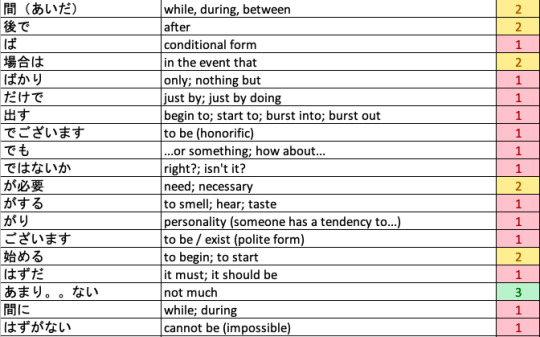

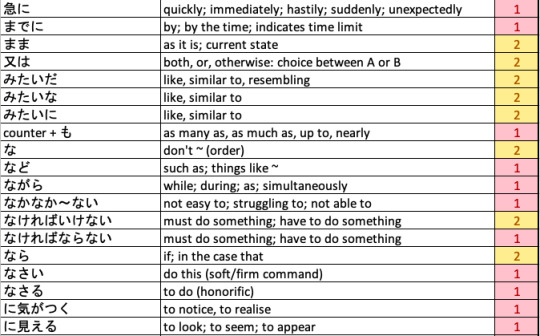
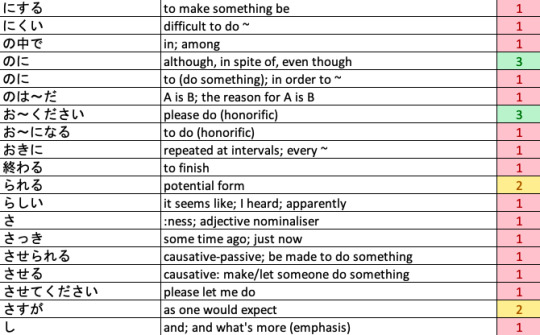
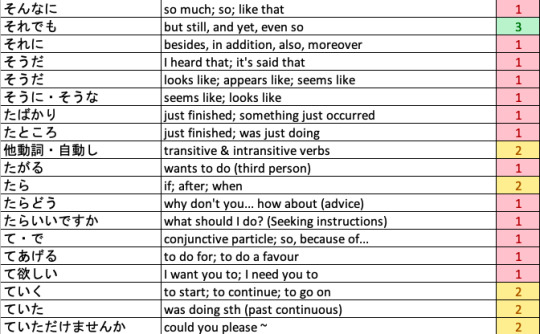

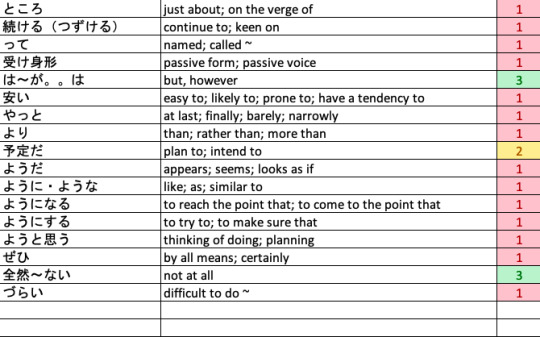
Copied the list of grammar I have to learn for JLPT N4 from JLPT Sensei into an excel spreadsheet and given everything a ranking based on how I feel about each topic. 3 = I’m confident I can use this grammar and correctly answer questions about it. 2 = I’ve studied it, but I’m unsure about it and might not get exam questions correct. 1 = I haven’t studied it or I’ve completely forgotten how to use it.
Deadline for applications is the 14th, so I have a little under 2 weeks to decide if I want to try for it. If come the 13th I’ve managed to make a good dent in these grammar concepts (as well as the vocabulary) then I’ll apply. If I’ve made no progress or very little progress, I won’t. Setting myself a challenging goal is one thing, but I need to make sure it’s a realistic goal too.
#japanese#japanese langblr#learning japanese#jlpt#90 concepts i've not studied#33 i've studied but don't know that well#90 days until the exam#if i can study 2 new concepts and review 1 every day then i'll have at least looked at everything by mid-may#but anyway let's see how this trial period goes lol#lots of these concepts are actually pretty simple so i just need to practice using them#it's just a question of remember which form of the verb/adjective/noun i need to use with them most of the time
39 notes
·
View notes
Text
getting dressed
There are 6 different ways to say "to wear", and this website explains it well!
In summary:
着る (きる)ー for clothes you wear from head down
履く (はく)ー for clothes you wear from legs up
かぶる ー for things that go on the head (hats, crowns, caps etc.)
する ー for accessories, neckties, gloves, make-up
つける ー for perfumes, surgical masks, rings
かける ー for glasses
サイズが合うかどうか、着てみてください。(Please try it on to see whether or not it fits.)
Note to self - Duolingo taught that for rings, we can also use 嵌める(はめる)
Another note to self - Upon attempting N5 Vocabulary Exercise 3, I learnt that putting on a necktie can be ネクタイをしめて (dictionary form is しめる/締める)

#wearing#clothes#get dressed#japanese#japanese verbs#nihongo#japanese langblr#japanese language#studyjapanese
63 notes
·
View notes
Text

"Recently, Homicide threw a trash can at me and it smashed my ribs.
'I'm really feeling better'
is what I thought, but.
Sasaki's knees spiked me on that splash and smashed my sternum.
Dunno when I'll be able to do barbell squats again."
#el desperado#my translation#njpw#ddt#I can't tell how bad any of these injuries actually are but he doesn't use the word 折る so hopefully nothing is actually broken#el desperado please take some time off to rest and relax#Thanks to this tweet I learned that there's a verb for 'getting your knees up and hurting an opponent diving onto you' in Japanese#I don't think there's a verb for that in English so I had to fiddle with the sentence structure to make it make any sense in English#The verb is 剣山さる and it's something you do to the move (not to the person who is doing the move)#so: スプラッシュを剣山された
11 notes
·
View notes
Text
Preference & Suitability in Japanese
JLPT N3 Verbs
好む このむ to like, to prefer
似合う にあう to suit
気に入る きにいる to take a liking to
流行る はやる to be popular, to come into fashion

#日本語#japanese#japanese language#japanese langblr#japanese studyblr#langblr#studyblr#単語#語彙#japanese vocabulary#jlpt n3#tokidokitokyo#tdtstudy#jlpt n3 verbs
61 notes
·
View notes